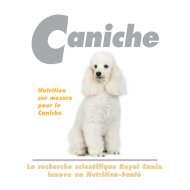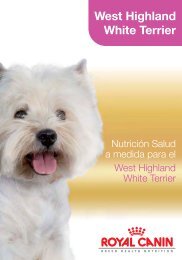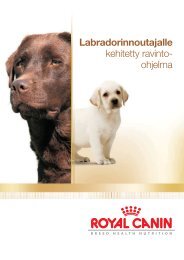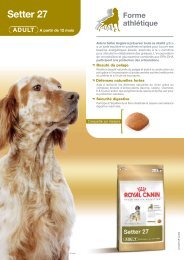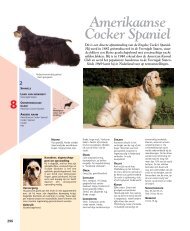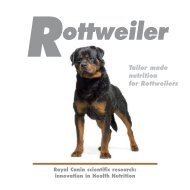You also want an ePaper? Increase the reach of your titles
YUMPU automatically turns print PDFs into web optimized ePapers that Google loves.
Borage oil, which is rich in<br />
GLA, is incorporated in<br />
products used to promote<br />
the suppleness and elasticity<br />
of the skin. It is especially<br />
advisable for dogs whose<br />
coat tends to feel greasy<br />
(seborrhoea).<br />
© J.-M. Labat<br />
They are not stored in the body. Generally speaking, a balanced diet<br />
and synthesis by intestinal bacteria ensure an adequate quantity in the<br />
body. This synthesis may however be limited in the event of a large<br />
water loss or antibiotic treatments.<br />
The beneficial effect of feeding this complex is seen after around two<br />
months.<br />
Preventing any fatty acid deficiency<br />
Whilst limiting the fat content in a food, it is important not to deprive the dog of<br />
essential fatty acids, which the body is unable to synthesise. In the event of a deficiency<br />
the skin suffers major desquamation, which is manifested by dandruff and an alteration<br />
in the skin barrier function.<br />
Essential fatty acids rebalance the composition of the superficial lipidic film to limit the skin<br />
drying (Fray et al, 2004) and play a key role in maintaining good skin health. Long-chain<br />
omega 3 fatty acids provided by fish oil (EPA and DHA*:<br />
0.4% in Cocker 25) are widely used in human and<br />
veterinary dermatology (Byrne et al, 2000).<br />
20<br />
The balance of fatty acids is achieved through the association<br />
of chicken fat, fish oil and vegetable oil (borage,<br />
soy).<br />
It is important to provide good nutritional support to<br />
the skin in the face of environmental agents and<br />
hypersensitivity reactions.



